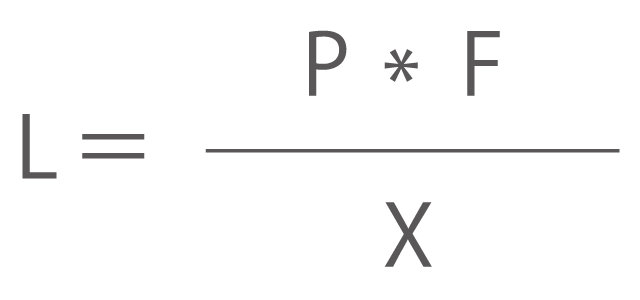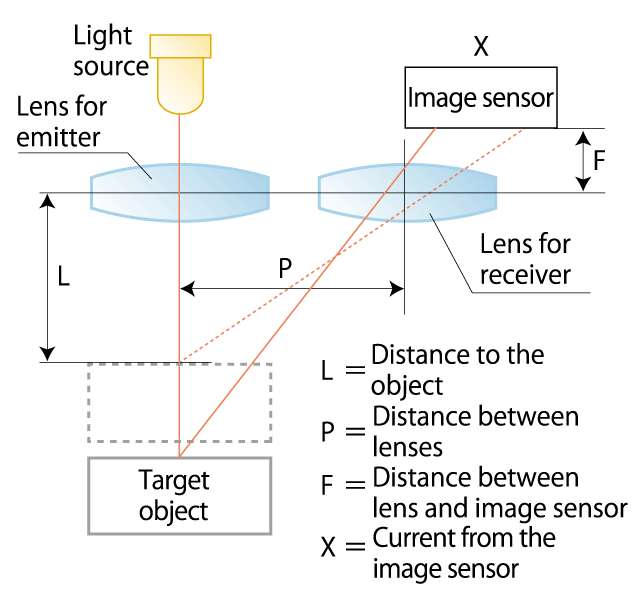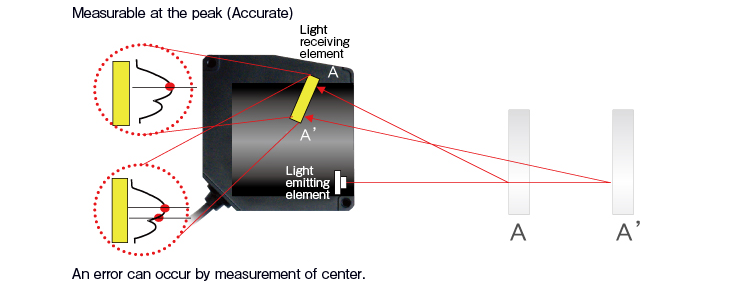Technical Guide for Displacement Sensors
1. Principle of laser displacement sensor
-
The laser beam is collected and collimated by the lens and emitted to the target object.
The reflected light from the object is received by the image sensor through the lens for receiver.
The distance of the target object moves changes distance of the landed image on the image sensor which creates current internally in the displacement sensor.
The distance “L” can be calculated by following formula using this current amount.
-

page top 
2. Differences by Image Sensor
-
C-MOS and CCD image sensors can measure a light intensity per pixel.
Thus, in case of fluctuation in the light intensity within the light spot influenced from surface conditions of the object as shown in the drawing below, an accurate position of light peak can be measured.
Compared with the PSD sensor, this eliminates an error caused by a color and gloss of the object.
page top 
3. Laser Classifications
| Laser class | Description |
|---|---|
| Class 1 | Safe under all conditions of normal use. This means the maximum permissible exposure (MPE) cannot be exceeded when viewing a laser with the naked eye or with the aid of typical magnifying optics (e.g. telescope or microscope |
| Class 1M | Safe for all conditions of use except when passed through magnifying optics such as microscopes and telescopes. |
| Class 2 | Considered to be safe because the blink reflex (glare aversion response to bright lights) will limit the exposure to no more than 0.25 seconds. It only applies to visible-light lasers (400.700 nm). |
| Class 2M | Safe because of the blink reflex if not viewed through optical instruments. As with class 1M, this applies to laser beams with a large diameter or large divergence, for which the amount of light passing through the pupil cannot exceed the limits for class 2. |
| Class 3R | Considered safe if handled carefully, with restricted beam viewing. With a class 3R laser, the MPE can be exceeded, but with a low risk of injury. Visible continuous lasers in Class 3R are limited to 5 mW. For other wavelengths and for pulsed lasers, other limits apply. |
| Class 3B | Hazardous if the eye is exposed directly, but diffuse reflections such as those from paper or other matte surfaces are not harmful. The AEL for continuous lasers in the wavelength range from 315 nm to far infrared is 0.5 W. For pulsed lasers between 400 and 700 nm, the limit is 30 mJ. Other limits apply to other wavelengths and to ultrashort pulsed lasers. Protective eyewear is typically required where direct viewing of a class 3B laser beam may occur. Class-3B lasers must be equipped with a key switch and a safety interlock. |
| Class 4 | Class 4 is the highest and most dangerous class of laser, including all lasers that exceed the Class 3B AEL. By definition, a class 4 laser can burn the skin, or cause devastating and permanent eye damage as a result of direct, diffuse or indirect beam viewing. These lasers may ignite combustible materials, and thus may represent a fire risk. These hazards may also apply to indirect or non-specular reflections of the beam, even from apparently matte surfaces.meaning that great care must be taken to control the beam path. Class 4 lasers must be equipped with a key switch and a safety interlock. |
page top 



